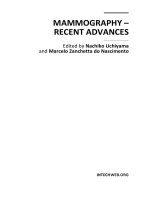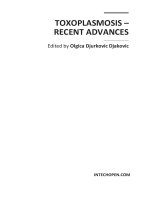Toxoplasmosis – Recent Advances docx
Bạn đang xem bản rút gọn của tài liệu. Xem và tải ngay bản đầy đủ của tài liệu tại đây (5.22 MB, 198 trang )
TOXOPLASMOSIS –
RECENT ADVANCES
Edited by Olgica Djurkovic Djakovic
Toxoplasmosis – Recent Advances
Edited by Olgica Djurkovic Djakovic
Contributors
Emmanuelle Gilot-Fromont, Maud Lélu, Marie-Laure Dardé, Céline Richomme, Dominique
Aubert, Eve Afonso, Aurélien Mercier, Cécile Gotteland, Isabelle Villena, Branko Bobić,
Ivana Klun, Aleksandra Nikolić, Olgica Djurković-Djaković, Eva Bartova, Kamil Sedlak, Lenka
Luptakova, Eva Petrovova, David Mazensky, Alexandra Valencakova, Pavol Balent, Vladimir
Ivović, Marija Vujanić, Tijana Živković, Pikka Jokelainen, Jean Dupouy-Camet, Hana Talabani,
Emmanuelle Delair, Florence Leslé, HélèneYera, Antoine P. Brézin, Lílian M.G. Bahia-Oliveira,
Alba L.P. Rangel, Marcela S.B. Boechat, Bianca M. Mangiavacchi, Livia M. Martins, Francielle B.
Ferraz, Maycon B. Almeida, Elisa M. Waked Peixoto, Flavia P. Vieira, Ricardo G. Peixe, Yoshiaki
Shimada
Published by InTech
Janeza Trdine 9, 51000 Rijeka, Croatia
Copyright © 2012 InTech
All chapters are Open Access distributed under the Creative Commons Attribution 3.0 license,
which allows users to download, copy and build upon published articles even for commercial
purposes, as long as the author and publisher are properly credited, which ensures maximum
dissemination and a wider impact of our publications. After this work has been published by
InTech, authors have the right to republish it, in whole or part, in any publication of which they
are the author, and to make other personal use of the work. Any republication, referencing or
personal use of the work must explicitly identify the original source.
Notice
Statements and opinions expressed in the chapters are these of the individual contributors and
not necessarily those of the editors or publisher. No responsibility is accepted for the accuracy
of information contained in the published chapters. The publisher assumes no responsibility for
any damage or injury to persons or property arising out of the use of any materials,
instructions, methods or ideas contained in the book.
Publishing Process Manager Vedran Greblo
Typesetting InTech Prepress, Novi Sad
Cover InTech Design Team
First published September, 2012
Printed in Croatia
A free online edition of this book is available at www.intechopen.com
Additional hard copies can be obtained from
Toxoplasmosis – Recent Advances, Edited by Olgica Djurkovic Djakovic
p. cm.
ISBN 978-953-51-0746-0
Contents
Preface IX
Section 1 Epidemiology and Epizootiology 1
Chapter 1 The Life Cycle of Toxoplasma gondii
in the Natural Environment 3
Emmanuelle Gilot-Fromont, Maud Lélu,
Marie-Laure Dardé, Céline Richomme,
Dominique Aubert, Eve Afonso, Aurélien Mercier,
Cécile Gotteland and Isabelle Villena
Chapter 2 Toxoplasma gondii Infection in South-East Europe:
Epidemiology and Epizootiology 37
Branko Bobić, Ivana Klun, Aleksandra Nikolić
and Olgica Djurković-Djaković
Chapter 3 Toxoplasmosis in Animals in the Czech Republic
– The Last 10 Years 55
Eva Bartova and Kamil Sedlak
Chapter 4 Toxoplasmosis in Livestock
and Pet Animals in Slovakia 75
Lenka Luptakova, Eva Petrovova, David Mazensky,
Alexandra Valencakova and Pavol Balent
Section 2 Molecular Diagnosis and Epidemiology 101
Chapter 5 Molecular Detection and Genotyping
of Toxoplasma gondii from Clinical Samples 103
Vladimir Ivović, Marija Vujanić, Tijana Živković,
Ivana Klun and Olgica Djurković-Djaković
Chapter 6 Endemic Toxoplasma gondii
Genotype II Causes Fatal Infections
in Animal Hosts in Europe – Lessons Learnt 121
Pikka Jokelainen
VI Contents
Section 3 Clinical Issues 127
Chapter 7 Risk Factors, Pathogenesis
and Diagnosis of Ocular Toxoplasmosis 129
Jean Dupouy-Camet, Hana Talabani, Emmanuelle Delair,
Florence Leslé, HélèneYera and Antoine P. Brézin
Chapter 8 Immunological and Immunogenetic Parameters on
the Diversity of Ocular Toxoplasmosis: Evidence to Support
Morphological Criteria to Classify Retinal/Retinochoroidal
Scar Lesions in Epidemiologic Surveys 145
Lílian M.G. Bahia-Oliveira, Alba L.P. Rangel, Marcela S.B. Boechat,
Bianca M. Mangiavacchi, Livia M. Martins, Francielle B. Ferraz,
Maycon B. Almeida, Elisa M. Waked Peixoto, Flavia P. Vieira
and Ricardo G. Peixe
Chapter 9 Pseudo Toxoplasmosis 173
Yoshiaki Shimada
Preface
During a time span of more than a century since its recognition, the protozoan parasite
Toxoplasma gondii has never seized to fascinate researchers. A ubiquitous organism
able to infect all mammals and birds, that has been estimated to infect one third of the
global human population, deserves as much. Recognized in the early days as an agent
affecting the fetus, the clinical focus has moved with the advent of AIDS and increased
use of treatments with immunosuppressive effect, to toxoplasmosis as an
opportunistic infection, and in the recent years back again to the long known ocular
disease, this time as a consequence of acquired as much as congenital disease.
Developments were always associated with the use of the leading methodologies of
the times, currently embodied in the penetration of molecular biology methods into
medicine and microbiology, which allowed for studies of T. gondii and the infection it
induces at the genomic level. In addition, T. gondii owes part of its popularity to being
a very desirable model of intracellular infection quite easy to grow in the lab, offering
the possibility to study various immunological, biochemical, cell biology and other
aspects and providing a wealth on data on immune control, host-parasite relationship,
etc. It is thus not surprising that the centenary of T. gondii presented an inspiration for
a number of texts and books overviewing both the biology of the organism and the
clinics of the disease it causes. In this regard, it is hard to find a niche for yet another
book on toxoplasmosis. However, any effort on compiling a series of essays stands
witness to its moment in the history of knowledge development, and offers its readers,
specialist or not, a view on the current achievements and research interests.
A current approach to this zoonosis is the concept of „one health“, based on the
understanding that a disease occurring between animals and man in a specific
environment can only be dealt with at the interface of all „players“ involved. The
structure of this book follows this concept, in that it integrates human and animal data
in its respective parts. The book is opened by a formidable chapter on factors affecting
the dynamics of the T. gondii life cycle, in which Gilot-Fromont and colleagues
describe how these elements shape the spatial and temporal variability of the
epidemiological dynamics, and conclude on the evolutionary and medical
implications of these variations.
In line with the „one health“ concept, this part is continued by a review (Chapter 2) of
both the epidemiology and the epizootiology of toxoplasmosis in South-East Europe.
X Preface
Bobić and colleagues review the data published in this region in the past two decades,
showing that a prevention effort requires concerted action on the animal, human and
environmental side, thereby illustrating on real facts the need for a complex and
unified approach advocated in Chapter 1.
The issue of epizootiology introduced by Bobić and colleagues is subject of the
following two contributions, which review the current data on T. gondii infection in
animals in the Chech Republic and Slovakia, respectively. Whereas Bartova and
colleagues (Chapter 3) offer a comprehensive review of T. gondii infection in farm, wild
and zoo animals in the Chech Republic in the last decade, in Chapter 4 Luptakova and
colleagues overview their own data on toxoplasmosis in animals in Slovakia, focusing
on the diagnostic methods available and discussing their advantages and pitfalls.
Part 2 is devoted to molecular epidemiology. Chapter 5 involves a text by Ivović and
colleagues on the use of molecular methods for the diagnosis of toxoplasmosis,
focusing on their advantages and limitations, as well as for the genotyping of strains
isolated from clinical samples, providing data on the molecular epidemiology of T.
gondii in Serbia.
The next chapter (Chapter 6) is an interesting text by P. Jokelainen, who shows that T.
gondii strains of the most common pan-European genotype II may be, and have been,
fatal for some of their animal hosts including mountain hares and foxes, in Finland but
elsewhere in Europe as well. This is a good reminder that whereas insight into the
parasite genotypes is expected to provide answers to many clinical questions, it is not
the parasite genotype but the interplay and balance between the parasite and its host,
with its different immunological responses, genetics etc., that determines the outcome
of infection.
Part 3 concerns important clinical issues of toxoplasmosis. Chapter 7 is an
authoritative account by Jean Dupouy-Camet and colleagues on the epidemiology of
ocular toxoplasmosis as the major T. gondii induced clinical entity, occurring as an
early or late consequence of acquired as much as of congenital disease. This relatively
novel concept changes our view of acquired infection, making a strong case for the
prevention of acquired infection in the general population.
Ocular toxoplasmosis in the particular setting of Brazil is further explored in Chapter 8
by Bahia-Oliveira and colleagues. As known to those familiar with the current
literature, toxoplasmosis seems to be an entirely different disease in Brazil. Initially
recognized after hydric epidemics, insight into strain differences at the molecular level
provided explanation for the significant clinical differences observed in Brazil vs.
elsewhere. Bahia-Oliveira and colleagues further explore the multifactorial nature of
ocular toxoplasmosis, and based on own research on clinical, immunological and
genetic parameters in a large patient series in an endemic area, propose a novel clinical
classification of retinochoroidal scars in epidemiological surveys.
Preface XI
The book is concluded by a text on so-called pseudo-toxoplasmosis (Chapter 9), in
which Shimada overviews i.e. genetic disorders causing clinical symptoms that can be
initially mis-diagnosed for toxoplasmosis and in which toxoplasmosis should be ruled
out in the differential diagnosis. One such case published by the author is here
discussed in the light of other entities that may mimick toxoplasmosis, focusing on
specific methods and examinations needed to distinguish between the two.
Dr. Olgica Djurković-Djaković
National Reference Laboratory for Toxoplasmosis
Centre of Excellence in Biomedicine
Institute for Medical Research, University of Belgrade
Serbia
Section 1
Epidemiology and Epizootiology









